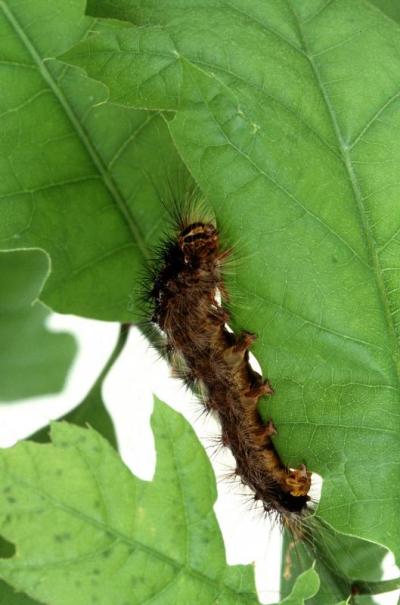Towns look to combat gypsy, winter moth invasion
After caterpillars wreaked havoc on the town’s trees, Marion Tree Warden Margie Baldwin and the Park Committee are asking residents to approve a $10,000 appropriation at Special Town Meeting in October to slow down the infestation next spring. While Rochester is keeping an eye on the issue, Mattapoisett is taking another approach to combat the insect invasion.
It was hard to miss the countless numbers of gypsy and winter moth caterpillars this spring. The invasive species hatched, crawled to the nearest branch and quickly nibbled away the spring foliage, from oak leaves to pine needles.
“Some of the trees were just totally laid bare,” said Baldwin. “I got a lot of phone calls from people. ‘What happened to my trees?’ People were definitely concerned.”
Baldwin said the snowy winter insulated the moth eggs, and the dry spring didn’t help.
“If you have a wet spring, they don’t propagate as well, a dry spring and they take off,” she said. “Winter and gypsy [moths], they were back to back whammies.”
The problem, of course, was not unique to Marion. In Rochester, the gypsy moth caterpillars were legion, and the copious amount of feces dropping in wooded areas sounded like a light rain.
Rochester Tree Warden and Highway Surveyor Jeff Eldridge said there were more caterpillars this spring than he has seen before, but he doesn’t have plans to spray.
“It was pretty bad. I’d never seen them eat pine trees before,” Eldridge said. “The biggest thing is waiting to see what ones come back and what ones don’t come back.”
Town Administrator Mike McCue, an amateur arborist, said he’s been told last spring’s “outbreak” of gypsy moths was the worst since 1981.
“I clearly remember as a child in Weymouth my family and our neighbors actively organizing and killing the caterpillars,” he said.
He also said the high numbers are part of a one to five year cycle and that many of the moths died in the caterpillar stage, so they never got to the reproduction stage.
Spraying may not be in order for Rochester, but McCue did say installing barrier tape to protect prevent caterpillars from climbing up tree trunks could be necessary.
That’s the strategy the Mattapoisett Tree Committee is employing, and they will teach residents how to do it.
“Spraying can be very effective, but it seems to be so sporadic,” said Tree Committee Chair Sandy Hering.
Two years ago, the committee commissioned spraying certain trees in Mattapoisett Village. This past spring, the town didn't spray any trees, but some of the previously sprayed trees did continue to resist the moth invasion, others didn't fare as well.
Hering said Mattapoisett Neck Road, in particular, received some of the worst damage.
She also said it’s the winter moth caterpillars that are causing the biggest problem. The moths first appeared in the area in 2003, Hering said, compared with gypsy moths, introduced around 1869 in Massachusetts.
The winter moth larvae hatch before the gypsy moths, crawl into the buds and chew up the leaves before they even open.
“They’re all half eaten instead of coming out as a tiny leaf,” Hering explained.
Thankfully, many trees did refoliate in late spring and early summer, but a string of bad years could kill them off.
“The trees will releaf as they have, but it’s tough on them and strains them. They can’t do this year after year,” Baldwin said.
New Marion Park Committee member David Pierce was the first to suggest spraying Marion’s trees, and Baldwin said originally she thought the service would be too expensive. She spoke with Bartlett Tree Experts who said it would cost just under $10,000 to spray the Village and the major roads, including Converse Road, Delano and Point Road. Because Route 6 is a state road, it will not be sprayed by the town.
Baldwin said spraying would only occur if it is deemed necessary next spring, and she said it would be safe.
“It’s not toxic to humans or pets. It would be done very early in the morning before people are out and about.”
The spraying would only be on public roadsides, not on private property.
With the number of calls she received about the moths in the spring and summer, Baldwin believes Special Town Meeting voters will be favorable to the appropriation on Oct. 26.
In Mattapoisett, the Tree Committee is taking a different approach. On Oct. 17, committee member Deborah Smiley will give a workshop on how to wrap tree trunks to prevent the caterpillars from climbing up them.
Banding the trees must be done around mid November before the winter moths lay their eggs, said Hering.
“That’s the reason we picked October, so that people could get their supplies after the workshop and band their trees.”
The exact location and time for the workshop will be available soon on the town’s website, mattaposiett.net.
This winter may also have a lot to do with how many caterpillars, of the gypsy or winter variety, appear next spring. Time will tell or as Eldridge puts it, “Mother nature is mother nature.”












